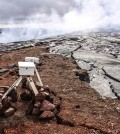Posts for tag "volcano"
Monitoring Volcanic Activity in Hawaii: Safeguarding Public Safety with the Hawaiian Volcano Observatory
The eight main Hawaiian Islands are made up of 15 volcanoes, six of which are active as of 2023. Many locals live on or near an active volcano, making the monitoring and understanding of volcanic activity a...
- Posted May 29, 2023
Sampling Volcanic Gases On Remote Aleutian Islands
University of New Mexico scientists sample the eastern Aleutian Islands’ volcanic gases, a blind spot in current knowledge of global carbon emissions.
- Posted February 22, 2016
Volcanic Eruptions Linked To Global Temperature Fluctuations
When scientists talk about millennial-scale climate change, they have to deal with a lot of uncertainty because there is still so much to be learned about the mechanisms that act on such long timescales. However, one Durham...
- Posted December 14, 2015
Modeling Effort Examines Impacts Of Decades-Long Lava Flows On Ancient Earth
Researchers from Europe and the United States have modeled the effects of some of Earth’s ancient volcanic eruptions, according to a release from the University of California, Berkeley. The eruptions of the time, dating back more than...
- Posted December 4, 2015
Accurate Modeling Tools Could Help Mitigate Effects Of Hawaii’s Vog
Efforts to characterize “vog” emissions from Kilauea Volcano have been underway for some time, including those looking to turn the findings into modeling tools.
- Posted November 12, 2015
U. Bristol, Columbia Scientists Say Volcanic Collapse Can Cause Mega Tsunamis
A chance find of stranded boulders in the Cape Verde islands leads U. Bristol researchers on an isotopic hunt to investigate a mega tsunami event.
- Posted October 19, 2015
Previewing Future Climate Change Ocean Effects Possible Near Volcanic Vents
According to a press release from the University of Adelaide in Australia, it is possible to glimpse what futures ocean life might encounter with climate change by looking at carbon dioxide-seep volcanic vents. In these areas, acidification...
- Posted August 18, 2015
British Researchers Link Volcanic Eruptions, Climate Cooling
It is well known that volcanic eruptions can influence weather patterns. However, scientists at the British Antarctic Survey and other research groups have tied volcanic eruptions specifically to cooling events that have occurred around the globe, according...
- Posted August 17, 2015
Massive Magma Chamber Found Under Yellowstone
Yellowstone National Park is already known for the supervolcano lying dormant under its caldera. But that isn’t the only significant volcanic entity in the park: University of Utah researchers have just discovered a massive reservoir of partially...
- Posted May 19, 2015
MIT undergrads characterize Kīlauea’s volcanic smog
Undergraduate students at MIT use sulfur dioxide and aerosol measuring devices to characterize volcanic smog coming out of Hawaii’s Kīlauea volcano.
- Posted April 20, 2015
Study identifies lava sources for Kīlauea, a long-erupting Hawaiian volcano
A recent study shows that the Hawaiian volcano Kīlauea has two sources of fuel for its extreme eruptions, according to a Live Science article. Geologists discovered this by analyzing chemical tracers from the last five decades of...
- Posted March 17, 2015
Friday Followup: Kīlauea Volcano lava flow approaches town
In the Summer 2014 print edition of the Environmental Monitor, we featured a photo of a laval flow from the Kīlauea Volcano on Hawaii’s Big Island creeping dangerously close to some U.S. Geological Survey’s monitoring equipment. As...
- Posted December 12, 2014














